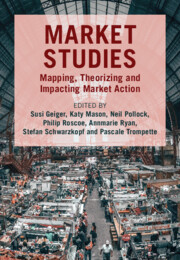Book contents
- Market Studies
- Market Studies
- Copyright page
- Contents
- Figures
- Tables
- Contributors
- Acknowledgements
- Introduction: The Multiple Pasts, Presents and Futures of Markets and Market Studies
- Part I Market Designs and Market Misfires
- Part II Post-Performative Approaches to Studying Markets
- Part III Valuation
- Part IV Markets in Motion: Places and Spaces
- Chapter 15 Going to a Safe Place: (Re)Qualifying Market Sites in the Context of a Global Pandemic
- Chapter 16 #CovidArcadia: The Pandemic Conditions of the Emergence of Digital-Affective Atmosphere
- Chapter 17 Making Space and Beating a Path to a Marketplace: The Uneven Spatial Ordering of Christmas Tourism Markets
- Chapter 18 Small Trading Circuits and Micro-Logistics in Pericapitalist Markets
- Part V The Secret Life of Market Studies Methods
- Part VI Broadening the Perspectives in Market Studies
- Part VII Future (Im)Perfect Markets
- Index
- References
Chapter 17 - Making Space and Beating a Path to a Marketplace: The Uneven Spatial Ordering of Christmas Tourism Markets
from Part IV - Markets in Motion: Places and Spaces
Published online by Cambridge University Press: 22 November 2024
- Market Studies
- Market Studies
- Copyright page
- Contents
- Figures
- Tables
- Contributors
- Acknowledgements
- Introduction: The Multiple Pasts, Presents and Futures of Markets and Market Studies
- Part I Market Designs and Market Misfires
- Part II Post-Performative Approaches to Studying Markets
- Part III Valuation
- Part IV Markets in Motion: Places and Spaces
- Chapter 15 Going to a Safe Place: (Re)Qualifying Market Sites in the Context of a Global Pandemic
- Chapter 16 #CovidArcadia: The Pandemic Conditions of the Emergence of Digital-Affective Atmosphere
- Chapter 17 Making Space and Beating a Path to a Marketplace: The Uneven Spatial Ordering of Christmas Tourism Markets
- Chapter 18 Small Trading Circuits and Micro-Logistics in Pericapitalist Markets
- Part V The Secret Life of Market Studies Methods
- Part VI Broadening the Perspectives in Market Studies
- Part VII Future (Im)Perfect Markets
- Index
- References
Summary
This chapter contributes a means of teasing out the uneven spatial ordering of markets. Taking inspiration from Schatzki’s (1991, 2001) practice-based spatial ontology, we introduce a four-part scheme made up of ‘anchors’; ‘places’; ‘settings’; and ‘paths’. We ground the concepts in an empirical account of the Finnish Lapland’s emergence as the official ‘home’ of Santa Claus and the related historical constitution of a Christmas tourism market. With the future of market studies research in mind, we argue that this conceptual framework provides a way of thinking about market making as an inherently spatial process, while also supporting investigations of how markets and the concerns they help produce take shape unevenly over time and across physical space.
- Type
- Chapter
- Information
- Market StudiesMapping, Theorizing and Impacting Market Action, pp. 280 - 293Publisher: Cambridge University PressPrint publication year: 2024

